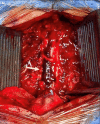Spontaneous Spinal Epidural Hematoma Associated With Short-Term Dual Antiplatelet Therapy: A Case Report
- PMID: 36304344
- PMCID: PMC9586495
- DOI: 10.7759/cureus.29415
Spontaneous Spinal Epidural Hematoma Associated With Short-Term Dual Antiplatelet Therapy: A Case Report
Abstract
Spinal epidural hematoma (SEDH), either spontaneous or traumatic, is a rare neurosurgical emergency. Typically, the natural history is a sudden onset of severe neck or back pain, associated with neurological deficit, either immediately or after a short period of the pain onset. MRI is the gold standard investigation. The mainstay of treatment is spinal decompression, in the form of laminectomy or hemilaminectomy, with the evacuation of the hematoma. The occurrence of SEDH has been strongly associated with coagulopathy, especially that induced by anticoagulant use. The association between SEDH and antiplatelet therapy has been scarcely reported in the literature. We report a case of spontaneous SEDH in a patient who was on dual antiplatelet therapy. Our case is unique because the patient had been using antiplatelet agents for only six weeks prior to this diagnosis. As antiplatelet agents are widely prescribed, physicians should be able to anticipate SEDH as a possible complication of dual antiplatelet therapy to facilitate early treatment and better outcomes.
Keywords: antiplatelet therapy; dual antiplatelet therapy; neck pain; quadriparesis; spinal epidural hematoma; stroke mimic.
Copyright © 2022, Alahmadi et al.
Conflict of interest statement
The authors have declared that no competing interests exist.
Figures



Similar articles
-
Recurrent Cervical Spinal Epidural Hematoma: Case Report and Literature Review.NMC Case Rep J. 2020 Sep 15;7(4):157-160. doi: 10.2176/nmccrj.cr.2019-0253. eCollection 2020 Sep. NMC Case Rep J. 2020. PMID: 33062561 Free PMC article.
-
A Spontaneous Spinal Epidural Hematoma Secondary to Long-Term Low-Dose Aspirin and Clopidogrel Use: A Case Report.Cureus. 2023 Feb 2;15(2):e34537. doi: 10.7759/cureus.34537. eCollection 2023 Feb. Cureus. 2023. PMID: 36879714 Free PMC article.
-
Spontaneous thoracic epidural hematoma: a case report and literature review.Childs Nerv Syst. 2016 Jan;32(1):181-7. doi: 10.1007/s00381-015-2768-5. Epub 2015 Jun 2. Childs Nerv Syst. 2016. PMID: 26033378 Review.
-
[A case of acute spinal epidural hematoma in a patient with antiplatelet therapy].No Shinkei Geka. 1989 Sep;17(9):849-53. No Shinkei Geka. 1989. PMID: 2797370 Japanese.
-
Spontaneous spinal epidural hematoma: a case report and review of the literatures.Acta Neurol Taiwan. 2012 Mar;21(1):31-4. Acta Neurol Taiwan. 2012. PMID: 22879087 Review.
Cited by
-
A rare etiology of sudden onset severe back pain: spinal subarachnoid hemorrhage.World J Emerg Med. 2025 Jul 1;16(4):410-412. doi: 10.5847/wjem.j.1920-8642.2025.080. World J Emerg Med. 2025. PMID: 40708734 Free PMC article. No abstract available.
-
Delayed neurological dysfunction following posterior laminectomy with lateral mass screw fixation: A case report and review of literature.World J Clin Cases. 2024 Mar 6;12(7):1356-1364. doi: 10.12998/wjcc.v12.i7.1356. World J Clin Cases. 2024. PMID: 38524505 Free PMC article.
-
Spontaneous Spinal Epidural Hematoma Under Rivaroxaban and Clopidogrel: A Case Report and Literature Review.Open Access Emerg Med. 2025 Feb 21;17:129-135. doi: 10.2147/OAEM.S489072. eCollection 2025. Open Access Emerg Med. 2025. PMID: 40007880 Free PMC article.
References
-
- Case of spinal apoplexy. Jackson R. Lancet. 1869;94:5–6.
-
- Spinal epidural haematoma; factors influencing outcome. Mukerji N, Todd N. Br J Neurosurg. 2013;27:712–717. - PubMed
-
- Spinal hematoma: a literature survey with meta-analysis of 613 patients. Kreppel D, Antoniadis G, Seeling W. Neurosurg Rev. 2003;26:1–49. - PubMed
-
- Spontaneous spinal epidural haematoma: management and main risk factors in era of anticoagulant / antiplatelet treatment. Stetkarova I, Ehler E, Brabec K, et al. Neurol Neurochir Pol. 2021;55:574–581. - PubMed
Publication types
LinkOut - more resources
Full Text Sources
Research Materials
